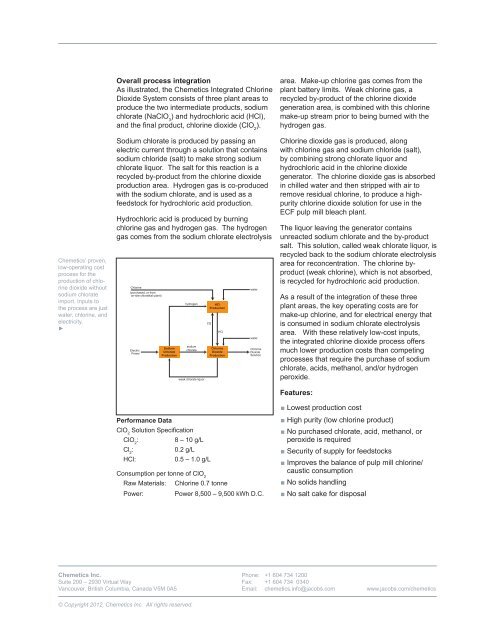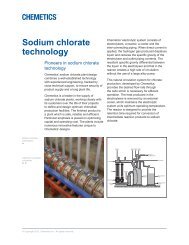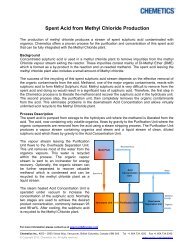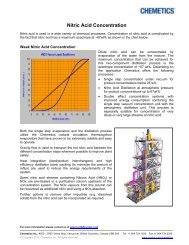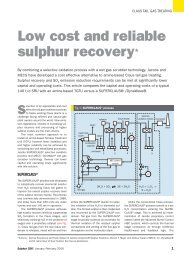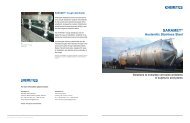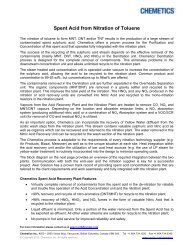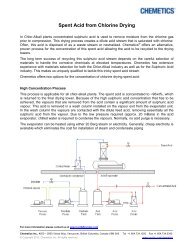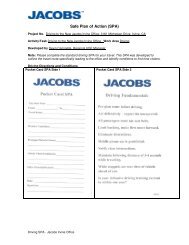Integrated chlorine dioxide technology
Integrated chlorine dioxide technology
Integrated chlorine dioxide technology
You also want an ePaper? Increase the reach of your titles
YUMPU automatically turns print PDFs into web optimized ePapers that Google loves.
Chemetics’ proven,<br />
low-operating cost<br />
process for the<br />
production of <strong>chlorine</strong><br />
<strong>dioxide</strong> without<br />
sodium chlorate<br />
import. Inputs to<br />
the process are just<br />
water, <strong>chlorine</strong>, and<br />
electricity.<br />
►<br />
Overall process integration<br />
As illustrated, the Chemetics <strong>Integrated</strong> Chlorine<br />
Dioxide System consists of three plant areas to<br />
produce the two intermediate products, sodium<br />
chlorate (NaClO 3 ) and hydrochloric acid (HCl),<br />
and the final product, <strong>chlorine</strong> <strong>dioxide</strong> (ClO 2 ).<br />
Sodium chlorate is produced by passing an<br />
electric current through a solution that contains<br />
sodium chloride (salt) to make strong sodium<br />
chlorate liquor. The salt for this reaction is a<br />
recycled by-product from the <strong>chlorine</strong> <strong>dioxide</strong><br />
production area. Hydrogen gas is co-produced<br />
with the sodium chlorate, and is used as a<br />
feedstock for hydrochloric acid production.<br />
Hydrochloric acid is produced by burning<br />
<strong>chlorine</strong> gas and hydrogen gas. The hydrogen<br />
gas comes from the sodium chlorate electrolysis<br />
Chlorine<br />
(purchased, or from<br />
on-site chloralkali plant)<br />
Electric<br />
Power<br />
Sodium<br />
Chlorate<br />
Production<br />
hydrogen<br />
sodium<br />
chlorate<br />
weak chlorate liquor<br />
Performance Data<br />
ClO Solution Specification<br />
2<br />
ClO : 8 – 10 g/L<br />
2<br />
Cl : 0.2 g/L<br />
2<br />
HCl: 0.5 – 1.0 g/L<br />
Consumption per tonne of ClO2 Raw Materials: Chlorine 0.7 tonne<br />
Power: Power 8,500 – 9,500 kWh D.C.<br />
© Copyright 2012, Chemetics Inc. All rights reserved.<br />
HCl<br />
Production<br />
Cl2<br />
HCl<br />
Chlorine<br />
Dioxide<br />
Production<br />
water<br />
water<br />
Chlorine<br />
Dioxide<br />
Solution<br />
area. Make-up <strong>chlorine</strong> gas comes from the<br />
plant battery limits. Weak <strong>chlorine</strong> gas, a<br />
recycled by-product of the <strong>chlorine</strong> <strong>dioxide</strong><br />
generation area, is combined with this <strong>chlorine</strong><br />
make-up stream prior to being burned with the<br />
hydrogen gas.<br />
Chlorine <strong>dioxide</strong> gas is produced, along<br />
with <strong>chlorine</strong> gas and sodium chloride (salt),<br />
by combining strong chlorate liquor and<br />
hydrochloric acid in the <strong>chlorine</strong> <strong>dioxide</strong><br />
generator. The <strong>chlorine</strong> <strong>dioxide</strong> gas is absorbed<br />
in chilled water and then stripped with air to<br />
remove residual <strong>chlorine</strong>, to produce a highpurity<br />
<strong>chlorine</strong> <strong>dioxide</strong> solution for use in the<br />
ECF pulp mill bleach plant.<br />
The liquor leaving the generator contains<br />
unreacted sodium chlorate and the by-product<br />
salt. This solution, called weak chlorate liquor, is<br />
recycled back to the sodium chlorate electrolysis<br />
area for reconcentration. The <strong>chlorine</strong> byproduct<br />
(weak <strong>chlorine</strong>), which is not absorbed,<br />
is recycled for hydrochloric acid production.<br />
As a result of the integration of these three<br />
plant areas, the key operating costs are for<br />
make-up <strong>chlorine</strong>, and for electrical energy that<br />
is consumed in sodium chlorate electrolysis<br />
area. With these relatively low-cost inputs,<br />
the integrated <strong>chlorine</strong> <strong>dioxide</strong> process offers<br />
much lower production costs than competing<br />
processes that require the purchase of sodium<br />
chlorate, acids, methanol, and/or hydrogen<br />
peroxide.<br />
Features:<br />
■ Lowest production cost<br />
■ High purity (low <strong>chlorine</strong> product)<br />
■ No purchased chlorate, acid, methanol, or<br />
peroxide is required<br />
■ Security of supply for feedstocks<br />
■ Improves the balance of pulp mill <strong>chlorine</strong>/<br />
caustic consumption<br />
■ No solids handling<br />
■ No salt cake for disposal<br />
Chemetics Inc. Phone: +1 604 734 1200<br />
Suite 200 – 2930 Virtual Way Fax: +1 604 734 0340<br />
Vancouver, British Columbia, Canada V5M 0A5 Email: chemetics.info@jacobs.com www.jacobs.com/chemetics


